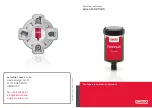
Unit setup and connection
FAM 5
en-US
Page 38 / 148
BEWA FAM5 4166129a en-us 2019-03-04.docx
2019-03-04
Notes on pipes and hoses
NOTICE
Non-permitted pressure at the inlet IN / outlet OUT
Risk of malfunctions
►
Determine the pressure to be anticipated at the inlet/outlet with the
prescribed values.
Make sure that the cross-section of the connected hoses/piping is at least as
large as the cross-section of the inlet/outlet port sizes.
In order to keep the pressure loss as low as possible, use as few threaded
connections as possible. Connect all connectors to the FAM without initial
stress.
The pressure at the inlet P
e
/ outlet P
a
depends on the height differential
between the FAM fluid surface in the tank port (aspiration height
∆
P
(height)
)
and the line losses (
∆
P
(line)
).
If the FAM is above the fluid surface in the tank, determine the pressure as
follows:
P
e
= -
∆
P
(Height)
-
∆
P
(Line)
P
a
= -
∆
P
(height)
+
∆
P
(line)
If the FAM is below the fluid surface in the tank, determine the pressure as
follows:
P
e
= +
∆
P
(Height)
-
∆
P
(Line)
P
a
= +
∆
P
(height)
+
∆
P
(line)
Caution: P
e perm
/P
a perm
refers to the inlet/outlet FAM without hose.
The respective values for P
e perm
/P
a perm
can be found in the technical data on
page 139.
Determine the pressure loss
∆
P
(height)
as follows:
∆
P
(height)
[bar] = h/10.
Here, h refers to the distance between the suction port on the FAM and the
fluid surface in the tank.
The pressure loss in a hydraulic line (
∆
P
(line)
) depends on the following:
•
Volumetric flow
•
Kinematic viscosity
•
Pipe dimensions
Summary of Contents for FAM 5 FluidAqua Mobil
Page 147: ......
















































